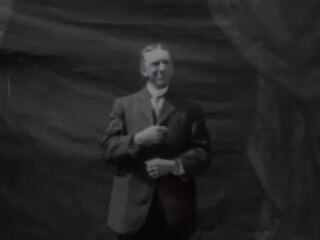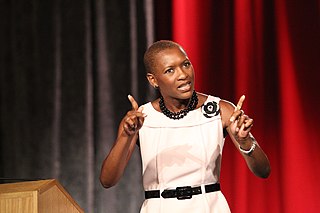The disability rights movement is a global social movement that seeks to secure equal opportunities and equal rights for all people with disabilities.

Deaf culture is the set of social beliefs, behaviors, art, literary traditions, history, values, and shared institutions of communities that are influenced by deafness and which use sign languages as the main means of communication. When used as a cultural label especially within the culture, the word deaf is often written with a capital D and referred to as "big D Deaf" in speech and sign. When used as a label for the audiological condition, it is written with a lower case d. Carl G. Croneberg coined the term "Deaf Culture" and he was the first to discuss analogies between Deaf and hearing cultures in his appendices C/D of the 1965 Dictionary of American Sign Language.

Deaf President Now (DPN) was a student protest in March 1988 at Gallaudet University, Washington, D.C. The protest began on March 6, 1988, when the Board of Trustees announced its decision to appoint a hearing candidate, Elizabeth Zinser, over the other Deaf candidates, Irving King Jordan and Harvey Corson, as its seventh president.
The history of deaf people and deaf culture make up deaf history. The Deaf culture is a culture that is centered on sign language and relationships among one another. Unlike other cultures the Deaf culture is not associated with any native land as it is a global culture. By some, deafness may be viewed as a disability, but the Deaf world sees itself as a language minority. Throughout the years many accomplishments have been achieved by deaf people. To name the most famous, Ludwig van Beethoven and Thomas Alva Edison were both deaf and contributed great works to culture.
Frank G. Bowe was a deaf American disability studies academic who served as the Dr. Mervin Livingston Schloss Distinguished Professor for the Study of Disabilities at Hofstra University. As a disability rights activist, author, and teacher, he accomplished a series of firsts for individuals with disabilities.

George William Veditz was an American educator, filmmaker, and activist who served as the seventh President of the National Association of the Deaf from 1904 to 1910. He is remembered as one of the most ardent and visible advocates of American Sign Language (ASL) and was one of the first people to film ASL. His 1913 film "Preservation of the Sign Language" was added to the National Film Registry in 2010.

The National Black Deaf Advocates (NBDA) is an advocacy organization for thousands of Black deaf and hard of hearing people in the United States. Black Deaf leaders were concerned that deaf and hard-of-hearing African-Americans were not adequately represented in leadership and policy decision-making activities that were affecting their lives.

Preservation of the Sign Language is a fourteen-minute film, presented without subtitles, featuring George Veditz, onetime president of the National Association of the Deaf (NAD) of the United States, demonstrating in sign language the importance of defending the right of deaf people to sign as opposed to verbalizing their communication. Deafened by scarlet fever at the age of eight, Veditz was one of the first to make motion-picture recordings of American Sign Language. Taking care to sign precisely and in large gestures for the cameras, Veditz chose fiery biblical passages to give his speech emotional impact. In some of his films, Veditz used finger spelling so his gestures could be translated directly into English in venues where interpreters were present. On behalf of the NAD, Veditz made this film specifically to record sign language for posterity at a time when oralists were gaining momentum in the education of the deaf. The film conveys one of the ways that deaf Americans debated the issues of their language and public understanding during the era of World War I.

Claudia L. Gordon is the first deaf Black female attorney in the United States and the first deaf graduate of American University's law school. She currently works as a Senior Accessibility Strategy Partner at T-Mobile within its Diversity, Equity and Inclusion team. Prior to joining the telecom industry, Gordon held various roles in the public sector from 2002 to 2017—most notably as the associate director in the White House Office of Public Engagement, where she advised White House offices and senior officials including former President Barack Obama on disability issues. This political appointment made Gordon the first deaf person to work at the White House in a detailee capacity.
Beth S. Benedict is a professor in the Department of Communication Studies at Gallaudet University, advocate for the deaf, and a mentor for families with deaf children. Her research focuses on early intervention, early language acquisition, and family involvement. Benedict is also an advocate for the use of bilingualism in education of the deaf - incorporating the value of American Sign Language in deaf children. Benedict advocates for deaf-hearing partnerships, avoiding audism, the importance of bilingual education, deaf culture and the use of sign language while also working as a family mentor for families with deaf children. Recently, she was a keynote speaker for an International Deaf Studies conference and the featured speaker for the deaf education summit. Benedict takes what she researches about deafness and education and shares it broadly by way of talks and application - for example, she has helped the Georgia School for the Deaf work on developing bilingual education in their programs. In 2015 Benedict was the featured speaker at the Deaf education summit in Louisiana - a conference that brought together practitioners, educators, and parents to discuss local issues surrounding education of deaf children.

The Deaf rights movement encompasses a series of social movements within the disability rights and cultural diversity movements that encourages deaf and hard of hearing to push society to adopt a position of equal respect for them. Acknowledging that those who were Deaf or hard of hearing had rights to obtain the same things as those hearing lead this movement. Establishing an educational system to teach those with Deafness was one of the first accomplishments of this movement. Sign language, as well as cochlear implants, has also had an extensive impact on the Deaf community. These have all been aspects that have paved the way for those with Deafness, which began with the Deaf Rights movement.

Braam Jordaan is a South African entrepreneur, filmmaker, animator, and activist. He is an advocate for Sign Language and human rights of Deaf people, and a board member of the World Federation of the Deaf Youth Section. In 2009, Jordaan collaborated with the Canadian Cultural Society of the Deaf and Marblemedia on the first children's animated dictionary of American Sign Language, which allows deaf children to look up words in their own primary language of ASL along with the English counterpart. The dictionary allows both deaf children and their hearing parents to learn sign language together.

Opeoluwa Sotonwa is a Deaf Nigerian American attorney, disability rights advocate and literary writer. In February 2021, Governor Charles Baker appointed Dr. Sotonwa as the Commissioner and agency head for the Massachusetts Commission for the Deaf and Hard of Hearing. Prior to his appointement as Commissioner, he was the executive director of Missouri Commission for the Deaf and Hard of Hearing. and served previously as Vice President of the National Black Deaf Advocates, the official advocacy organization for thousands of Black Deaf and Hard of Hearing Americans between 2013 and 2015. He is listed among the most influential Deaf People in the United States Opeoluwa Sotonwa attended University of Ilorin Nigeria, where he read law and graduated with LLB degree in 2005. He later proceeded to Nigerian Law School for advanced legal training. He was called to the Nigerian Bar as a Barrister and Solicitor of the Supreme Court of Nigeria in 2007. Opeoluwa worked as staff attorney with Nigerian Legal Aid Council. He later moved to United States to further his legal career and attended Howard University School of Law, where he graduated cum laude with a Master of Laws degree in 2009. Dr. Sotonwa earned his doctorate in Law and Policy from Northeastern University's College of Professional Studies in 2018.

Dragonsani "Drago" Renteria is a deaf Chicano transgender man, CEO of DeafVision, founder and executive director of Deaf Queer Resource Center (DQRC) and long-time resident of San Francisco.
Mervin "Merv" Donald Garretson was an American educator, leader, and deaf community rights advocate. His works were primarily directed towards changing mainstream opinion about deaf culture and about the deaf community.

Steve Hamerdinger is an American deaf professional and advocate for deaf and hard of hearing people. He is the current Director of Deaf Services for the Alabama Department of Mental Health. His work revolves around contexts related to deaf and hard of hearing persons and their mental well-being from childhood to end of life. He is an advocate for Deaf rights and has been a prominent influence in this field since the early 1980s.
Gertrude Scott Galloway was an American educator and administrator working with deaf children. She was the first female president of the National Association of the Deaf. She is among the first deaf women to head a school for the deaf in the United States. Galloway was an advocate for deaf women throughout her life.

Angeline Fuller Fischer was an American writer. She is considered one of the earliest deaf feminists due to her advocacy for the equal education of deaf women. Her poems and articles were published in publications across the United States; in 1908 the newspaper The Silent Worker called Fischer "one of America's great deaf poets".
Roslyn "Roz" Goodstein Rosen is an American advocate for the Deaf community. Rosen was the president of the National Association of the Deaf from 1990 to 1993 and was a board member for the World Federation of the Deaf from 1995 to 2003. She served in multiple academic administrator roles throughout her career, including as the Vice President for Academic Affairs at Gallaudet University, and was the director of the National Center on Deafness from 2006 to 2014.












